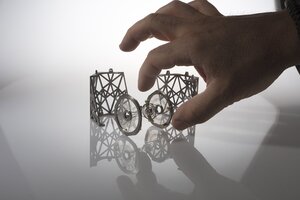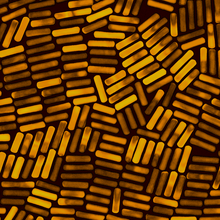When Astrobotic’s Peregrine lunar lander launches from Cape Canaveral on its way to the moon, the payload will include the MoonArk, a 10-ounce time capsule that was designed by Illinois alumni to last on the surface of the moon for thousands of years.
At only eight inches high and two inches in diameter, the metal MoonArk sculpture has four stacked chambers packed with hundreds of images, poems, music, mechanisms, earthly samples, and nano-objects, including nanorods fabricated in the lab of professor Catherine J. Murphy, Larry R. Faulkner Endowed Chair in Chemistry, and Head, Department of Chemistry.
The MoonArk project has been led by a team of Carnegie Mellon University faculty members that include Illinois alums of the College of Fine and Applied Arts: Mark Baskinger (MFA ’01 Industrial Design), who is the project director, and Matt Zywica (BFA, ’02) and another Illinois alum, Mark Rooker (BFA ’92 Graphic Design; MFA ’99 Metals; MFA ’00 Graphic Design), who is a faculty member at James Madison University.
Baskinger has worked on the project for more than 10 years along with fellow CMU faculty and students and a host of international collaborators, involving more than 20 international companies and universities, and 60 team members.
Today, Baskinger said, the sum of their “work embodied in 10 ounces of material represents an immense effort from distributed teams, individual artists and designers, students, scholars, researchers, scientists, technologists, explorers, curators, photographers, educators, musicians, and interesting people doing really interesting things.” One of the contributing scientists is Murphy (BS, ‘86), who is also an Illinois alum.
Murphy’s contribution to the MoonArk is gold nano-sized (less than a billionth of a meter) rods, basically tiny metal particles, that are fabricated in the Murphy lab for many research and other purposes such as chemical sensing and biological imaging.
"My lab members, past and present, are so excited that our nanorods will be on the moon,” Murphy said. “It is fascinating to conjecture who will visit the Moon a thousand years from now, and what they will make of our nanoscale color exhibit."
The “nanoscale color exhibit” features brilliant colors that are generated when light interacts with conduction band electrons in the metal nanorods, producing what is known as a plasmon resonance at particular optical frequencies. The absorption and scattering of light by gold and silver nanorods can be tuned throughout the visible and near-infrared portions of the electromagnetic spectrum.
After successfully passing space-readiness vibration, electrical, thermal and vacuum testing, the MoonArk has been installed onto the lander deck and will soon be delivered to Cape Canaveral. The Peregrine lunar lander was designed and built by Astrobotic, a Pittsburgh company and Carnegie Mellon University spinoff partnering with NASA. Peregrine will also be flying payload for NASA and more than a dozen other projects from various groups, including the first lunar rover, Iris.
In 2008, professor Lowry Burgess initiated the Moon Arts Group at CMU which conceived of many artistic expressions for and on the moon. The MoonArk, proved the most viable, yet most challenging concept to pursue. With Astrobotic’s buy-in and support, the project commenced in 2009 in the Frank-Ratchye STUDIO for Creative Inquiry at CMU. With the cost of payload aboard the Peregrine at $1.2 million per kilogram, the CMU team quickly realized its work would have to be nearly weightless.
Rooker, who completed his BFA in graphic design at Illinois and then two MFA degrees at Illinois, one in graphic design and another in metals, fabricated most of the metal work inside the MoonArk.
A pentagonal structure with four independent but interrelated exoskeletal chambers – Earth, Metasphere, Moon, and Ether – the MoonArk contains elements representing the Arts, Humanities, Sciences, and Technologies. The chambers encompass the most advanced state-of-the-art material and fabrication practices – from the nano- and micro- scales, to the infinite scales including ever ongoing deep space radio-wave transmissions broadcast in 2016 in advance of the MoonArk’s journey in 2023.
Earlier this year, NASA announced the landing site for Peregrine near Ocean of Storms on the western part of the moon’s near side. Peregrine will be powered to the moon by United Launch Alliance’s Vulcan Centaur rocket.
An identical MoonArk, which has traveled the world for display at exhibitions, festivals, and presentations, will remain on Earth. In April 2022, the twin MoonArk was accessioned into the permanent collection of the Smithsonian National Air and Space Museum.
— By Tracy Crane, Department of Chemistry



